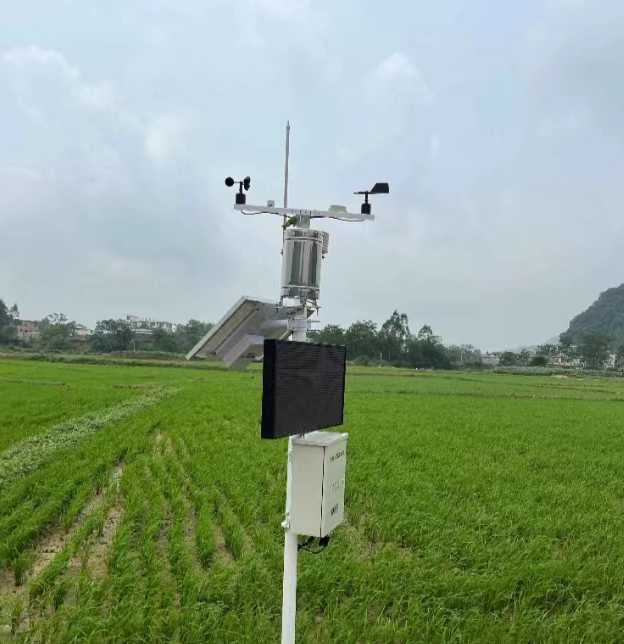

— Blogs —
—Products—
 Consumer hotline +8618073152920
Consumer hotline +8618073152920 WhatsApp:+8615367865107
Address:Room 102, District D, Houhu Industrial Park, Yuelu District, Changsha City, Hunan Province, China
Product knowledge
Time:2024-08-28 16:41:54 Popularity:2269
Weather stations play a vital role in monitoring environmental conditions, providing valuable data for agriculture, research and daily weather forecasting. In order to operate continuously, these stations require a reliable power source. In this paper, we will explore the power consumption of a typical weather station equipped with six sensors and how solar energy can be an efficient and sustainable power solution.
In exploring the power consumption of a weather station equipped with six key sensors, we first need to understand how much power each sensor consumes and how they work together to contribute to the overall system's energy consumption. This weather station is equipped with wind speed, wind direction, temperature, humidity, barometric pressure, and rainfall sensors, each of which consumes 0.3 watts (W). Next, we will calculate the total power consumption of these sensors for a day and a year, and explore the feasibility of using a 60 W solar panel and a 30 Ah lithium battery as the power system.
A standard weather station usually consists of six sensors for measuring wind speed, wind direction, temperature, humidity, barometric pressure and rainfall. In this case, the power consumption of each sensor is 0.3 W.
Let's calculate the daily and annual power consumption.
-Each sensor works 24 hours a day.
Power consumption per sensor per day = 0.3 W x 24 hours = 7.2 (Wh)
-Total power consumption of 6 sensors per day = 7.2 Wh × 6 = 43.2 Wh or 0.0432 kWh
Assuming that the weather station operates every day of the year: -Annual power consumption = 0.0432 kWh
-Annual power consumption = 0.0432 kWh × 365 days = 15.758 kWh
Therefore, the weather station consumes about 0.0432 kWh of electricity per day and 15.758 kWh of electricity per year.

To sustainably power the weather station, a solar system consisting of solar panels and batteries can be used. The system consists of a 60W solar panel and a 30AH Li-ion battery. Now, let's evaluate the power supply capacity of the 60W solar panel and the 30Ah Li-ion battery.
- A 60W solar panel can produce 60 watts of electricity per hour under optimal conditions (full sunlight).
-In order to determine if the panel can support a weather station, we need to compare its daily output with the daily consumption of the weather station.
Note: Actual power generation can be affected by a variety of factors including weather, season, geographic location, and solar panel efficiency.
-The average number of hours of sunshine varies by location, but is generally estimated to be about 5 hours per day.
-Daily solar power generation = 60W × 5 hours = 300wh
The capacity of a 30AH battery needs to be converted to watt-hours by multiplying the battery voltage (usually assumed to be 12V for Li-ion batteries) by amp-hours.
-Battery capacity = 30AH × 12V = 360wh
Considering these figures, a 60W solar panel produces enough energy per day to power the weather station, and any excess energy can be stored in the battery. 30AH batteries provide sufficient storage to ensure continuous operation in low or no light conditions.
Solar systems are often designed to include a certain amount of redundancy to take into account weather variations and to ensure continuous operation. 60W solar panels are sufficient to meet or exceed the daily needs of the weather station described above, while the 30Ah lithium battery provides enough energy reserves to ensure that the system can operate for several days even during continuous cloudy and rainy days.
Conclusion
In summary, a weather station equipped with six sensors, with each sensor consuming 0.3 W, consumes about 1.58 kWh of electricity in a year. using a 60 W solar panel and a 30 Ah Li-ion battery as the power supply system, under ideal conditions, the system is able to adequately satisfy the power demand of the weather station, and there may be surplus power available for other purposes or for storage in case of emergencies.
However, the actual operating effect will be affected by a variety of factors, including weather conditions, the efficiency of the solar panel, the charging and discharging efficiency of the lithium battery, and the specific operating conditions of the weather station. Therefore, these factors need to be taken into account in the actual application, and appropriate system optimisation and adjustment may be required.
This green, self-sufficient energy solution not only reduces the dependence on the traditional power grid, but also reflects the sustainable development path of modern weather monitoring technology. Through rational design and maintenance, solar-powered weather stations can operate efficiently and stably, providing reliable data support for environmental monitoring and scientific research.
Related recommendations
Sensors & Weather Stations Catalog
Agriculture Sensors and Weather Stations Catalog-NiuBoL.pdf
Weather Stations Catalog-NiuBoL.pdf
Related products
 Combined air temperature and relative humidity sensor
Combined air temperature and relative humidity sensor Soil Moisture Temperature sensor for irrigation
Soil Moisture Temperature sensor for irrigation Soil pH sensor RS485 soil Testing instrument soil ph meter for agriculture
Soil pH sensor RS485 soil Testing instrument soil ph meter for agriculture Wind Speed sensor Output Modbus/RS485/Analog/0-5V/4-20mA
Wind Speed sensor Output Modbus/RS485/Analog/0-5V/4-20mA Tipping bucket rain gauge for weather monitoring auto rainfall sensor RS485/Outdoor/stainless steel
Tipping bucket rain gauge for weather monitoring auto rainfall sensor RS485/Outdoor/stainless steel Pyranometer Solar Radiation Sensor 4-20mA/RS485
Pyranometer Solar Radiation Sensor 4-20mA/RS485
Screenshot, WhatsApp to identify the QR code
WhatsApp number:+8615367865107
(Click on WhatsApp to copy and add friends)
